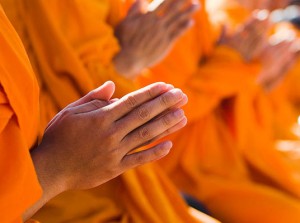An excerpt from a teaching called The Seven Limb Puja: Viewing the Guru by Jetsunma Ahkon Norbu Lhamo on October 18, 1995
Since we find that we are, in fact, in the presence of the primordial Guru at every single moment, what is the posture that we should take? You should refer to the practice called the Seven Limb Puja. The Seven Limb Puja appears in many different practices in slightly different variations, but it has certain common denominators, and these should be studied and looked at as a guide of how one should practice now that one is coming to understand that the eyes of the Guru are our eyes; that the heart of the Guru is our heart; that in our nature, that is the nature. That is the nature, and we are indistinguishable in our nature from that.
Practicing in that way we should think like this. First of all, in the face of the Guru, knowing that the face of the Guru is always with us, we should practice paying homage constantly. Constantly paying homage to the Guru, this will antidote our pride, our ego, that habit that says, “Oh, well, look at that! The Guru has faults. He or she must be human.” And, of course, that is the statement that keeps you from practicing pure devotion and pure surrender, and the same statement that prevents you from achieving realization. So this is the antidote that helps you to give rise to that spiritual posture that makes it possible for you recognize the nature of the Guruas the absolute non-dual display of emptiness and luminosity; and to give rise to profound devotion at last, rather than the superficial stuff that we’ve been passing out as devotion.
We practice paying homage. We pay homage to the Buddhas and the Bodhisattvas; the Lamas are in that number. The Buddhas and Bodhisattvas are all represented in the Lama. We should think that we pay homage to the Buddhas because they have crossed the ocean of suffering. Therefore, they are capable of captaining us across the ocean of suffering. So we pay homage with that kind of regard, as though we needed to cross an ocean of suffering and the trip is scary and long and hazardous and difficult and so a qualified captain is required. Otherwise, we can’t make it. So that is the kind of recognition of the superior quality of the Buddhas and Bodhisattvas, of the Lama. Recognize every moment, this is a vajra command, that when we think of ourselves in our samsaric state and then we think of the Guru, we should think that the Guru is like a precious diamond, beyond compare, because the Guru is capable of helping us cross the ocean of suffering. We cannot do that ourselves. That will antidote the kind of pride that we have when we try to put ourselves above everything, in subtle or gross ways, whatever it happens to be.
© Jetsunma Ahkön Lhamo











